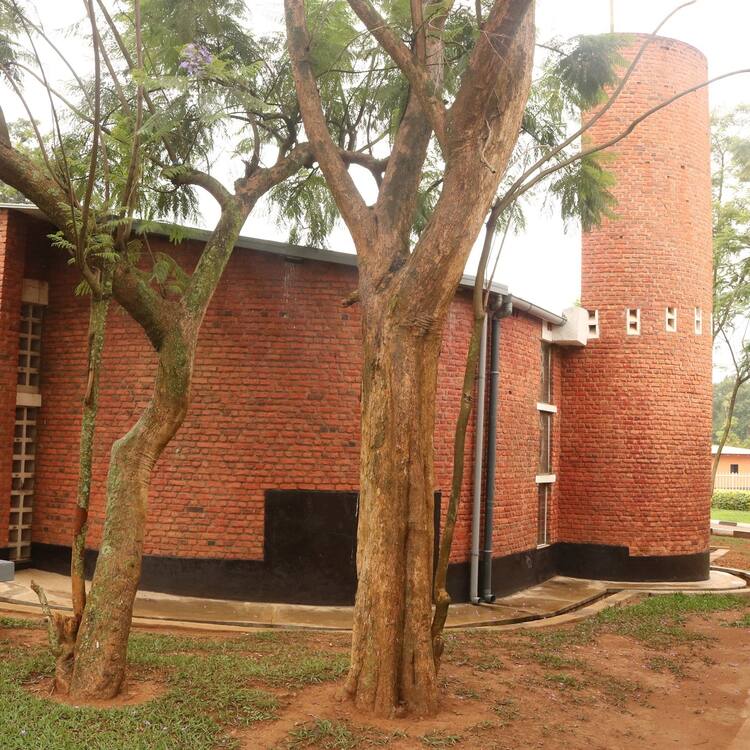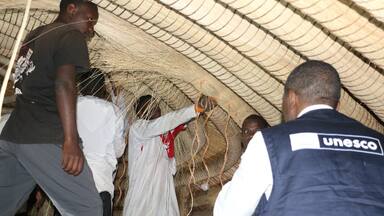Memorial sites of the Genocide: Nyamata, Murambi, Gisozi and Bisesero
Memorial sites of the Genocide: Nyamata, Murambi, Gisozi and Bisesero
Description is available under license CC-BY-SA IGO 3.0
Sites mémoriaux du génocide : Nyamata, Murambi, Gisozi et Bisesero
Description is available under license CC-BY-SA IGO 3.0
مواقع ذكرى الإبادة الجماعية: نياماتا ومورامبي وجيسوزي وبيسسيرو
source: UNESCO/CPE
Description is available under license CC-BY-SA IGO 3.0
种族大屠杀纪念地:恩亚玛塔、穆拉姆比、吉索兹和比瑟瑟罗
source: UNESCO/CPE
Description is available under license CC-BY-SA IGO 3.0
Мемориальные комплексы геноцида: Ньямата, Мурамби, Гисози и Бисеро
source: UNESCO/CPE
Description is available under license CC-BY-SA IGO 3.0
Sitios conmemorativos del Genocidio: Nyamata, Murambi, Gisozi y Bisesero
source: UNESCO/CPE
Description is available under license CC-BY-SA IGO 3.0
Outstanding Universal Value
Brief synthesis
The memorial sites of the Genocide: Nyamata, Murambi, Gisozi and Bisesero witnessed key events in the genocide perpetrated against the Tutsi in Rwanda, which claimed the lives of more than one million people over 100 days between April and July 1994.
Although the origins of the genocide can be traced back to ethnic differences which the colonial powers framed as political identities, the event has acquired universal significance because of its sudden intensity – the number of people killed in a relatively short space of time – and the way it was carried out – the premeditated and organized extermination of civilians by their neighbours, family members and militias. In addition, the genocide led to the establishment of the International Criminal Tribunal for Rwanda (1994-2015), which contributed to the process of creating the International Criminal Court (2002), as well as to the United Nations General Assembly’s decision, in 2003, to designate 7 April as International Day of Reflection on the 1994 Genocide against the Tutsi in Rwanda, in a bid to encourage a commitment to the fight against genocide worldwide.
The four memorial sites represent more than 200 places of worship, public places and places of resistance in Rwanda where massacres were committed, and encourage reflection and reconciliation, while playing an educational role in promoting a culture of peace and dialogue.
Two of the component parts of the property still bear traces of the massacre: the Nyamata Catholic Church, built in 1980 on the hill of the same name in the Eastern Province, and the Murambi Technical School, built in 1990 on the hill of the same name in the Southern Province. The third site, Gisozi hill in the city of Kigali, where more than 250,000 victims have been buried, is home to the Kigali Genocide Memorial built in 1999, while the fourth site, Bisesero hill in the Western Province, hosts a memorial built in 1998 to remember the fight of those who resisted their attackers for more than two months before being exterminated.
Criterion (vi): The memorial sites of the Genocide: Nyamata, Murambi, Gisozi and Bisesero are of Outstanding Universal Value because of the sudden intensity of the genocide, the scale of the massacre perpetrated against the Tutsis over 100 days and the extermination of civilians by family members, neighbours and militias. All these factors prompted the United Nations General Assembly in 2003 to designate 7 April as the International Day of Reflection on the 1994 Genocide against the Tutsi in Rwanda. The four memorial sites represent more than 200 places of worship, public places and places of resistance in Rwanda where massacres were committed. The Nyamata Catholic Church and Murambi Technical School are direct and tangible reminders of the genocide sites, the burial site on Gisozi hill reflects the scale of the tragedy, and Bisesero is associated with the struggle of those who resisted.
Integrity
The integrity of the memorial sites of the Genocide: Nyamata, Murambi, Gisozi and Bisesero lies in the ability of the attributes to convey Outstanding Universal Value, namely their completeness and intactness. The attributes are included within the boundaries of the four component parts, but an inventory of the main attributes would make it possible to establish a baseline for the conservation and management of the property.The integrity of the main building of the former church in Nyamata, preserved in the state it was in immediately after the massacres, is at risk from natural deterioration due to the construction materials, as well as from urban development due to its location. The integrity of the collections of movable heritage and of the evidence of the genocide preserved in the buildings within the component parts – such as the mummified bodies, skulls and personal effects of the victims – are highly vulnerable to environmental factors.
Authenticity
The authenticity of the property is based on the truthfulness and credibility with which the attributes convey the outstanding universal value. The church buildings retain a high degree of authenticity because their materials, form and design have remained as they were at the time of the massacre, while the school buildings are sufficiently intact and the collections in both cases vividly reflect the horrors of the massacres.
The history of the Tutsi genocide has been reported in an inclusive and diverse way. Testimonies have been collected from genocide survivors to document their experiences during the period of persecution. Accounts have been collected from perpetrators of the genocide in order to understand the political and/or social mechanisms and factors that led them to kill their compatriots. Other narrative elements have been collated during traditional court sessions. Testimonies have been collected from the Righteous to understand their motivations and the reasons for their resistance at the most dangerous times for them and their loved ones. Consultations have been held with elders and sages to understand the historical context in which the hatred that led to the genocide developed.
Interpretation not only of the way in which the four component parts reflect all the genocide sites in Rwanda, and contribute to greater understanding of the historical and geographical context of the genocide, but also of the reasons why its modus operandi has attracted the attention and concern of the international community, should be strengthened.
Protection and management requirements
The four memorial sites are protected by Law No. 28/2016 of 22/7/2016 on the preservation of cultural heritage and traditional knowledge, as well as by Ministerial Order No. 001/MINUBUMWE/24 of 08/02/2024 on the classification of tangible cultural heritage and the terms for its use and income generation.
In addition, the four component parts are protected under Law No. 15/2016 of 02/05/2016 governing ceremonies to commemorate the genocide against the Tutsi and organization and management of memorial sites for the genocide perpetrated against the Tutsi; Law No. 09/2007 of 16/02/2007 on the remit, organization and functioning of the National Commission for the Fight against Genocide (CNLG), which was replaced in 2021 by the Prime Ministerial Order No. 021/03 of 21/10/2021 determining the mission, remit and organizational structure of the Ministry of National Unity and Civic Engagement (MINUBUMWE), which took over the responsibilities of the CNLG; Organic Law No. 04/2004 of 08/04/2005 on how to protect, safeguard and promote the environment in Rwanda, Article 82 of which prohibits the dumping anywhere of any substances likely to destroy sites and monuments of scientific, cultural, tourist or historical interest; and the national policy on the fight against genocide, its ideology and the management of its consequences, drawn up in 2014. In addition, a national policy on National Unity and Civic Engagement has been developed, including a section on safeguarding the memory of the genocide against the Tutsi, as well as the establishment and maintenance of the Memorial sites of the Genocide and archives, including those of the Gacaca courts and the International Criminal Tribunal for Rwanda. A strategic plan is currently being prepared.
Management of the four memorial sites is the responsibility of the Ministry of National Unity and Civic Engagement (MINUBUMWE) in accordance with the Prime Ministerial Order No. 011/03 of 24/07/2023, which determines the mission, powers and organizational structure of the Ministry of National Unity and Civic Engagement. MINUBUMWE manages and preserves these sites using the human, financial and material resources provided by the Government. Each site has its own managers, governed by the status of civil servants, who are responsible for safeguarding the site on a daily basis.
Regularly updated management plans, including the 2023-2028 plan, serve as strategic tools for managing, protecting and monitoring the component parts of the serial property, but also for capacity-building through mechanisms involving local communities in the planning, management and protection of the sites. Heritage impact assessments should be included in the planning processes for buffer zones and the wider environment of the property.

